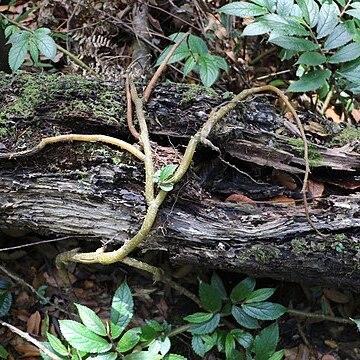Straggly herb to 1 (–2) m, rarely scandent, often with adventitious roots, sparsely pubescent, soon glabrescent; stems ± succulent. Leaves distichous; lamina asymmetrically elliptic to obovate or sometimes narrowly ovate, often slightly curved, (7–) 10–20 (–26) cm long, (2–) 3–7 (–10) cm wide, asymmetrically cuneate and auriculate at base, toothed/sharply dentate margin, acuminate apex, discolorous, glabrescent, dense with elongated cystoliths, lateral veins c. 8 or 9 pairs, prominent; petiole short (to 4 (–10) mm long) or absent. Inflorescence unisexual, capitate, pedunculate to subsessile. Male inflorescence: peduncle 2–9 cm long, head 10–20 (–25) mm diam.; flowers c. 1.5 mm long, tepals 4, stamens 4, pistillode minute. Female inflorescence: ± sessile or peduncle to c. 3 mm long, head c. 8–15 mm diam.; flowers c. 1.5 mm long, tepals 3, unequal, staminodes 3, reflexed. Achenes ellipsoidal, 1–2 mm long, c. 1 mm wide.
More
A fleshy herb. It keeps growing from year to year. It grows 30-60 cm high and spreads 30-45 cm wide. It forms coarse clumps. The stems are 30-60 cm long and bright green. The are fleshy and root at the base. The leaves are 7-15 cm long by 3.5-6 cm wide. The leaves are scattered up the stem. The leaves are soft and bright green. They have teeth along the edge. The leaves are edible. The male flower heads are 1-2.5 cm across and flattened and green. The female flower heads are 0.6-0.8 cm across and rounded and green. The flowers are about 0.2 cm across. The fruit are nuts 0.1 cm long.

